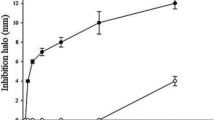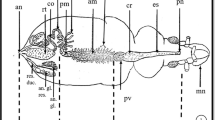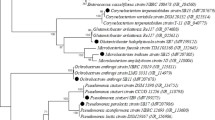Abstract
The burrower bug Scaptocoris castanea is an important soybean and pasture pest in Brazil, with an underground habit feeding directly on the sap of the roots. Underground habit hinders control and knowledge of the biology and physiology of this pest. This study describes the anatomy, histology, ultrastructure and symbionts of the midgut of S. castanea. The midgut of S. castanea is anatomically divided into five regions (ventricles). Ventricles 1–3 are similar between males and females, with cells specialized in digestion and absorption of nutrients, water transport and homeostasis. Ventricle 4 has squamous epithelium forming crypts and harboring bacteria in the lumen. Ventricle 5 of males is small with cells containing apical microvilli and broad basal folds with many openings for hemocoel, while in females, this region of the midgut is well developed and colonized by intracellular bacteria, characterizing bacteriocytes. The main bacteria are Gammaproteobacteria. The results show sexual dimorphism in ventricle 5 of the midgut of S. castanea, with formation of bacteriocytes in the females, while the other regions are involved in digestive processes in both sexes.











Similar content being viewed by others
References
Albuquerque-Cunha JM, Gonzalez MS, Garcia ES, Mello CB, Azambuja P, Almeida JCA, Souza W, Nogueira NFS (2009) Cytochemical characterization of microvillar and perimicrovillar membranes in the posterior midgut epithelium of Rhodnius prolixus. Athropod Struc Dev 38:31–44
Ambika S, Rajagopal R (2018) Lumen anatomy and localization of Wolbachia sp. in the thrips, Plicothrips apicalis (Bagnall). Curr Sci 115:1297–1304
Apprill A, Mcnally S, Parsons R, Weber L (2015) Minor revision to V4 region SSU rRNA 806R gene primer greatly increases detection of SAR11 bacterioplankton. Aquat Microb Ecol 75:129–137
Azevedo DO, Neves CA, Mallet JRS, Gonçalves TCM, Zanuncio JC, Serrão JE (2009) Notes on midgut ultrastructure of Cimex hemipterus (Hemiptera: Cimicidae). J Med Entomol 46:435–441
Baumann P, Moran NA (1997) Non-cultivable microorganisms from symbiotic association of insect and other hosts. Anton Leeuw 72:38–48
Burgos MH, Gutiérrez LS (1976) The intestine of Triatoma infestans. I Cytology of the midgut. J Ultrastruct Res 57:1–9
Caporaso JG, Lauber CL, Walters WA, Berg-Lyons D, Lozupone CA, Turnbaugh PJ, Fierer N, Knight R (2011) Global patterns of 16S rRNA diversity at a depth of millions of sequences per sample. Proc Natl Acad Sci U S A 108:4516–4522
Caporaso JG, Lauber CL, Walters WA, Berg-Lyons D, Huntley J, Fierer N, Ownens SM, Betley J, Fraser L, Bauer M, Gormley N, Gilbert JA, Smith G, Knignt R (2012) Ultra-high-throughput microbial community analysis on the Illumina HiSeq and MiSeq platforms. ISME J 6:1621–1624
Cavalcante VM, Cruz-Landim C (1999) Types of cells present in the midgut of the insects: a review. Naturalia 24:19–40
Chapman RF (2013) Insects: structure and function. Cambridge University Press, New York
Chen J, Mao S, Xu Z, Ding W (2019) Various antibacterial mechanisms of biosynthesized copper oxide nanoparticles against soilborne Ralstonia solanacearum. R Soc Chem Adv 9:3788–3799
Clark ME (2007) Wolbachia symbionts in arthropods. Wolbachia: a bug’s life in another bug. Karger, Basel (Switzerland)
Cossolin JFS, Martínez LC, Pereira MJB, Vivan LM, Bozdoğan H, Fiaz M, Serrão JE (2019) Anatomy, histology, and ultrastructure of salivary glands of the burrower bug, Scaptocoris castanea (Hemiptera: Cydnidae). Microsc Microanal 25:1482–1490
Costa C, Forti LC (1993) Ocorrencia de Scaptocoris castanea, Perty 1830 em pastagens cultivadas no Brasil. Pesq Agropec Bras 28:977–979
Couch EF, Mills RR (1967) The midgut epithelium of the american cockroach: acid phosphomonoesterase activity during the formation of autophagic vacuoles. J Insect Physiol 14:55–62
Cruz-Landim C, Serrão JE (1997) Ultrastructure and histochemistry of the mineral concretrions in the midgut of bees (Hymenoptera: Apidae). Neth J Zool 47:21–29
Del Bene G, Dallai R, Marchini D (1991) Ultrastructure of the midgut and the adhering tubular salivar glands of Frankliniella occidentalis (Pergande) (Thysanoptera: Thripidae). Int J Insect Morphol Embryol 20:15–24
Dou H, Yang S, Hu Y, Xu D, Liu L, Li X (2018) Sesamin induces ER stress-mediated apoptosis and activates autophagy in cervical cancer cells. Life Sci 200:87–93
Douglas AE (1989) Mycetocyte symbiosis in insect. Biol Rev 64:409–434
Douglas AE (2006) Phloem sap feeding by animals: problems and solutions. J Exp Bot 57:747–754
Edgar RC, Haas BJ, Clemente JC, Quince C, Knight R (2011) UCHIME improves sensitivity and speed of chimera detection. Bioinformatics 27:2194–2200
Elazouni I, Abdel-Aziz S, Rabea A (2019) Microbial efficacy as biological agents for potato enrichment as well as bio-controls against wilt disease caused by Ralstonia solanacearum. World J Microbiol Biotechnol 35:1–13
Fialho MCQ, Zanuncio JC, Neves CA, Ramalho FS, Serrão JE (2009) Ultrastructure of the digestive cells in the midgut of the predator Brontocoris tabidus (Heteroptera: Pentatomidae) after different feeding periods on prey and plants. Ann Entomol Soc Am 102:119–127
Fialho MCQ, Moreira NR, Zanuncio JC, Ribeiro AF, Terra WR, Serrão JE (2012) Prey digestion in the midgut of the predatory bug Podisus nigrispinus (Hemiptera: Pentatomidae). J Insect Physiol 58:850–856
Fialho MCQ, Terra WR, Moreira NR, Zanuncio JC, Serrão JE (2013) Ultrastructure and immunolocalization of digestive enzymes in the midgut of Podisus nigrispinus (Heteroptera: Pentatomidae). Arthropod Struct Dev 42:277–285
Fowler K, Partridge L (1989) A cost of mating in female fruitflies. Nature. 338:760–761
Gonçalves WG, Fernandes KM, Santana WC, Martins GF, Zanuncio JC, Serrão JE (2018) Post-embryonic development of the Malpighian tubules in Apis mellifera (Hymenoptera) workers: morphology, remodeling, apoptosis, and cell proliferation. Protoplasma 255:585–599
Grazia J, Schwertner CF, Silva EJE (2004) Arranjos taxonômicos e nomenclaturiais em Scaptocorini (Hemiptera: Cydnidae, Cephalocteinae). Neotrop Entomol 33:511–512
Guedes BAM, Zanuncio JC, Ramalho FS, Serrão JE (2007) Midgut morphology and enzymes of the obligate zoophytophagous stinkbug Brontocoris tabidus (Signoret, 1863) (Heteroptera: Pentatomidae). Pan-Pac Entomol 83:66–74
Guo Y, Hoffmann AA, Xu XQ, Huang HJ, Ju JF, Gong JT, Hong XY (2018) Wolbachia-induced apoptosis associated with increased fecundity in Laodelphax striatellus (Hemiptera: Delphacidae). Insect Mol Biol 27:796–807
Hosokawa T, Imanishi M, Koga R, Fukatsu T (2019) Diversity and evolution of bacterial symbionts in the gut symbiotic organ of jewel stinkbugs (Hemiptera: Scutelleridae). Appl Entomol Zool 54:359–367
Itoh H, Matsuura Y, Hokosakawa T, Fukatsu T, Kikychi Y (2017) Obligate gut symbiotic association in the sloe bug Dolicoris bacarum (Hemiptera: Pentatomidae). Appl Entomol Zool 52:51–59
Karamipour N, Fathipour Y, Meharabadi M (2016) Gammaproteobacteria as essential primary symbionts in the striped shield bug, Graphosoma leneatum (Hemiptera: Pentatomidae). Sci Rep 6:33168
Kikuchi Y (2009) Endosymbiotic bacteria in insects: their diversity and culturability. Microbes Environ 24:195–204
Kikuchi Y, Fukatsu T (2003) Diversity of Wolbachia endosymbionts in heteropteran bugs. Appl Environ Microbiol 69:6082–6090
Lehane MJ, Billingsley PF (1996) Biology of the insect midgut. Chapman & Hall, London
Lima AR, Colle AC, Santos FAS (2013) Percevejo castanho Scaptocoris castanea (Hemiptera: Cydnidae) como praga potencial em áreas de pastagens. Cascavel 6:1–12
Lipovsek S, Letofsky-Pabst I, Hofer F, Pabst MA (2002) Seasonal- and age-dependent changes of the structure and chemical composition of the spherites in the midgut gland of the harvestmen Gyas annulus (Opiliones). Micron 33:647–654
Lipovsek S, Letofsky-Papst I, Hofer F, Pabst MA, Devetak D (2012) Application of analytical electron microscopic methods to invstigate the function of spherites in the midgut of the larval antlion Euroleon nostras (Neuroptera: Myrmeolontidae). Microsc Res Tech 75:397–407
Matias FI, Sampaio MV, Coelho L, Grazia J (2011) Occurence of Scaptocoris castanea Perty (Hemiptera: Cydnidae) damaging Azadirachta indica (Meliaceae) seedlings in Brazil. Neotrop Entomol 40:288–289
Meng F (2013) Ralstonia solanacearum species complex and bacterial wilt disease. J Bacteriol Parasitol 4:e119
Moran NA (2007) Symbiosis as an adaptive process and source of phenotypic complexity. Proc Natl Acad Sci U S A 104:8627–8633
Nadarasah G, Stavrinides J (2011) Insects as alternative hosts for phytopathogenic bacteria. FEMS Microbiol Rev 35:555–575
Nardi JB, Mackie RI, Dawson JO (2002) Could microbial symbionts of arthropod guts contribute significantly to nitrogen fixation in terrestrial ecossystems? J Insect Physiol 48:751–763
Nardi JB, Miller LA, Bee CM (2019) Interfaces between microbes and membranes of host epithelial cells in hemipteran midguts. J Morphol 280:1046–1060
Oliveira LJ, Malaguido AB (2004) Flutuação e distribuição vertical da população do percevejo castanho da raiz, Scaptocoris castanea Perty (Hemiptera: Cydnidae), no perfil do solo em áreas produtoras de soja nas regiões centro-oeste e sudeste do Brasil. Neotrop Entomol 33:283–291
Parada AE, Needham DM, Fuhrman JA (2016) Every base matters: assessing small subunit rRNA primers for marine microbiomes with mock communities, time series and global field samples. Environ Microbiol 18:1403–1414
Pearse AGE (1960) Histochemistry theoretical and applied. J. & A. Churchill, London
Pessa LFC, Oliveira E, Nogueira RP (2013) Scaptocoris castanea (Perty, 1830) (Hemiptera, Cydnidae) em área produtora de Glycine max (L.) no município de Pimavera do Leste, Mato Grosso. Estud Biol 35:25–33
Pinheiro DO, Conte H, Gregório EA (2008) Spherites in the midgut epitelial cells of the sugercane borer parasitized by Cotesia flavipes. Biocell 31:61–67
Prado SS, Hung KY, Daugherty MP, Almeida RP (2010) Indirect effects of temperature on stink bug fitness, via maintenance of gut-associated symbionts. Appl Environ Microbiol 76:1261–1266
Quast C, Pruesse E, Yilmaz P, Gerken J, Schweer T, Yarza P, Peplies J, Glockner FO (2012) The SILVA ribosomal RNA gene database project: improved data processing and web-based tools. Nucleic Acids Res 41:D590–D596
Reynolds ES (1963) The use of lead citrate at high pH as an electron-opaque stain in electron microscopy. J Cell Biol 17:208–212
Salem H, Bauer E, Strauss AS, Vogel H, Marz M, Kaltenpoth M (2014) Vitamin supplementation by gut symbionts ensures metabolic homeostasis in an insect host. Proc R Soc B 281:1796
Santos HP, Rost-Roszkowska M, Vilimova J, Serrão JE (2017) Ultrastructure of the midgut in Heteroptera (Hemiptera) with diferente feeding habits. Protoplasma 254:1743–1753
Schloss PD, Handelsman J (2005) Introducing MOTHUR, a computer program for defining operational taxonomic units and estimating species richness. J Appl Environ Microbiol 71:1501–1506
Schloss PD, Westcott SL, Ryabin T, Hall JR, Hartmann M, Hollister EB, Lesniewski RA, Oakley BB, Parks DH, Robinson CJ, Sahl JW, Stres B, Thallinger GG, Van Horn DJ, Weber CF (2009) Introducing mothur: open-source, platform-independent, community-supported software for describing and comparing microbial communities. Appl Environ Microbiol 75:7537–7541
Serrão JE, Ronnau M, Neves CA, Campos LA, Zanuncio JC (2008) Ultrastructure of anterior midgut region of corbiculate bees (Hymenoptera: Apidae). Ann Entomol Soc Am 101:915–921
Silva CP, Ribeiro AF, Gulbenkian S, Terra WR (1995) Organization, origin and function of the outer microvillar (perimicrovillar) membranes of Dysdercus peruvianus (Hemiptera) midgut cells. J Insect Physiol 41:1093–1103
Simon-Delso N, Amaral-Rogers V, Belzunces LP, Bonmatin JM, Chagnon M, Downs C, Furlan L, Gibbons DW, Giorio C, Girolami V, Goulson D, Kreutzweiser DP, Krupke CH, Liess M, Long E, McField M, Mineau P, Mitchell EAD, Morrisey CA, Noome DA, Pisa L, Settele J, Stark JD, Taparo A, Van Dyck H, Van Praagh J, Van der Sluijs JP, Whitehorn PR, Wiemers M (2015) Systemic insecticides (neonicotinoids and fipronil): trends, uses, mode of action and metabolites. Environ Sci Pollut Res 22:5–34
Sohal RS, Peters PD, Hall TA (1977) Origin, structure, composition and age-dependence of mineralized dense bodies (concretions) in the midgut epithelium of the adult housefly, Musca domestica. Tissue Cell 9:87–102
Stefanini M, Demartino C, Zamboni L (1967) Fixation of ejaculated spermatozoa for electron microscopy. Nature 216:173–174
Teixeira AD, Fialho MCQ, Zanuncio JC, Ramalho FS, Serrão JE (2013) Degeneration and cell regeneration in the midgut of Podisus nigrispinus (Heteroptera: Pentatomidae) during post-embryonic development. Arthopod Struct Dev 42:237–246
Terra WR (1988) Physiology and biochemistry of insect digestion. An evolutionary perspective. Braz J Med Biol Res 21:675–734
Terra WR, Ferreira C (1994) Insect digestive enzymes: properties, compartimentalization and function. Comp Biochem Physiol 109:1–62
Terra WR, Costa RH, Ferreira C (2006) Plasma membranes from insect midgut cells. An Acad Bras Ciênc 78:255–269
Toh H, Weiss BL, Perkin SAH, Yamashita A, Oshima K, Hattori M, Aksoy S (2006) Massive genome erosion and functional adaptations provide insights into the symbiotic lifestyle of Sodalis glossinidius in tse tse host. Genome Res 16:149–156
Wang GF, Li H, Zhou Y, Yang LY, Ding ZJ, Huang JS, Pan BZ (2018) Bacterial wilt of Sacha inchi (Plukenetia volubilis) caused by Ralstonia pseudosolanacearum phylotype I in southern China. Plant Dis 103:364–365
Yanagi S, Miyatake T (2003) Costs of mating and egg production in female Callosobruchus chinensis. J Insect Physiol 49:823–827
Zhong J, Kong X, Zhang H, Yu C, Xu Y, Kang J, Yu H, Yi H, Yang X, Sun L (2012) Inhibition of CLIC4 enhances autophagy and triggers mitochondrial and ER stress-induced apoptosis in human glioma U251 cells under starvation. PLoS One 7:e39378
Acknowledgments
The authors thank José Carlos Gomes de Araújo, Gabriel dos Santos Carvalho and Fabiano Gonçalves Schimmer for their help in collecting insects on soybean crops; Dr. Lucia M. Vivan for identifying the insects; and Dr. André Rodrigues for photographs of the gut anatomy. We thank Dr. Luanda M. Santana for the revision of the manuscript. We are grateful to the Nucleus of Microscopy and Microanalysis of the Federal University of Viçosa for technical support.
Funding
This research was supported by the Brazilian research agencies National Council for Scientific and Technological Development (CNPq), Coordination of Improvement of Higher Education Personnel (CAPES), and Research Support Foundation of the State of Minas Gerais (FAPEMIG).
Author information
Authors and Affiliations
Corresponding author
Ethics declarations
Conflict of interest
The authors declare that they have no conflict of interest.
Ethical approval
This article does not contain any studies with animals or humans performed by any of the authors.
Additional information
Publisher’s note
Springer Nature remains neutral with regard to jurisdictional claims in published maps and institutional affiliations.
Electronic supplementary material
ESM 1
(PDF 113 kb)
Rights and permissions
About this article
Cite this article
Cossolin, J.F.S., Lopes, D.R.G., Martínez, L.C. et al. Morphology and composition of the midgut bacterial community of Scaptocoris castanea Perty, 1830 (Hemiptera: Cydnidae). Cell Tissue Res 382, 337–349 (2020). https://doi.org/10.1007/s00441-020-03197-7
Received:
Accepted:
Published:
Issue Date:
DOI: https://doi.org/10.1007/s00441-020-03197-7




